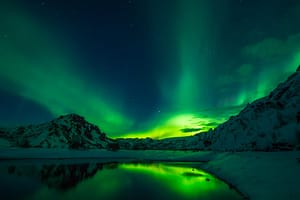Iceland’s history as a settled island is as iconic as its natural beauty, and began well before the arrival of the Norsemen in 874 AD. Archaeological excavations have revealed the ancient ruins of cabins in the Reykjanes Peninsula, believed to have been the homes of the Papar, the Celtic Christian monks who arrived several hundred years earlier as missionaries from Scotland. The settlements were abandoned when the Norsemen arrived.
The first settler, Ingolfr Arnarson, homesteaded in Reykjavik and was quickly joined by more Norsemen and their Irish and Scottish indentured serfs. By 50 years later, the world’s first parliament was established and most arable land had been claimed. The settlers adopted Christianity by 1000 AD although paganism quietly continued in remote areas.
Civil war on the island resulted in Iceland being taken over by the Norwegian crown in 1262, with the united Denmark-Norway Kalmar Union alliance taking over in 1380. Subsequently, volcanic eruptions, poor soil, and the harsh climate brought agricultural Iceland to its knees, and two outbreaks of the Black Death plague over the following 100 years reduced its population by more than half.
Religious conflict in Denmark in the 16th century resulted in the Reformation and the adoption of Lutheranism in Iceland, formerly a Catholic country. By the 17th and 18th centuries, Denmark’s harsh trading restrictions were again breaking down the country’s economic stability and the 18th century epidemic of smallpox decimated the community and was followed almost immediately by the eruption of the Laki Volcano in 1783.
The Mist Hardships caused by the fallout from the eruption killed more than 50 percent of the country’s livestock, and a devastating famine decimated the population yet again. During the 19th century, the climate inexplicably worsened, forcing around 15,000 of the island’s 70,000 population to emigrate, mostly to Canada. In spite of the ongoing disasters, a new independence movement took root in the 1850s, spurred on by romantic nationalism in Europe.
By 1874, Denmark had capitulated and granted Iceland limited home rule and a constitution and, in 1918, an agreement was signed between the two countries, recognizing Iceland as a sovereign state for 25 years under a personal union with the Danish king. After Germany’s WWII invasion of Denmark, the Icelandic government took over the duties of the Danish king. Four short weeks later, Iceland was invaded and occupied by the British Armed Forces, who were replaced by the Americans in 1941.
In 1943, the 25 years of the Danish-Icelandic Act of Union expired and 97 percent of Icelanders voted for an independent republic, finally established a year later. In 1946, the Americans departed and the unpopular decision to join NATO was ratified in 1949. Three years later, as part of their Cold War strategy, American forces returned to the island as the Iceland Defense Force, staying until 2006.
Economically, Iceland had profited during WWII and during the 1950s, it enjoyed strong growth, boosted by its industrialized fishing industry and aided by the Marshall Plan. Liberalization and diversification of the economy resulted after 1994 due to the country’s signing up to the European Economic Area. Its burgeoning role in international politics focused on peacekeeping and humanitarian issues, and included expertise and aid to Bosnian, Kosovan, and Iraqi NATO-led interventions.
By 2007, following the privatization of Icelandic banks in 2003; the country’s economy was focused on financial services and became hugely successful. However, the boom went spectacularly bust in 2008, fuelled by the sub-prime mortgage crisis in the US. All three Icelandic commercial banks failed, causing a run on deposits and the biggest banking collapse in world history. By 2009, 5,000 Icelanders had emigrated as a result of the economic chaos. The economy has since stabilized and is expected to be in growth again by 2013.
Along with the Icelandic language, Iceland’s culture is strongly rooted in Norse traditions, expressed in the still-popular Sagas and ancient literature. The sheer isolation of the country from its European neighbors has protected its culture from outside influences and preserved its language as a direct descendent of Old Norse. Many Icelanders still remember the names of their long-ago ancestors’ farms and it’s assumed that it’s not necessary to put place names on maps as most people know them.
Iceland’s varied and rich cultural streams stem from the country’s early literary heritage and embrace traditional crafts such as silver smithing, weaving, and wood carving, as well as folk songs and traditional dance. The Viking heritage is a source of great pride, with Viking traditions, mores, and beliefs inextricably woven into modern culture.
Art, music, and the iconic literature of the country and its peoples are a binding cultural force here, and traditional music still flourishes, often based on religious links. The epic Norse rhyming ballads trace back to Skaldic poetry and, with their form revitalized in the early 20th century, are still much-loved today. Landscape poetry depicts the unique beauty of Iceland’s topography and many of the most-loved poems date back almost unaltered to the ancient Icelandic sagas.

